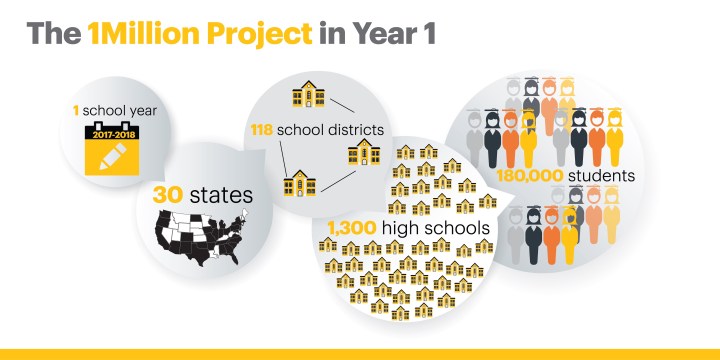
While more than 70 percent of the country’s high school teachers assign homework that requires the internet, 5 million families with children in school do not have internet connectivity at home to complete it. The 1Million Project sets out to eliminate this issue — also known as the “homework gap” — by providing students with the correct technological resources to pave the way for a successful future.
To start, Sprint pieced together research from school districts and other experts in the field in order to learn more about what students are lacking as well as what they need to succeed academically, Doug Michelman, president of the 1Million Project told Digital Trends. As for connectivity, the company also worked with its IT department to execute an efficient plan where the network identifies a new device being activated by a 1Million Project student in particular.
To find participants, Michelman explained that schools and school districts were instructed to apply for the program. In terms of criteria, a population of students who could be served by the need for internet and devices at home was essential. They also had to show a strong commitment to the project, along with devoted manpower to activate and execute the program in their school. Lastly, whether or not the Sprint network would provide a great experience from wherever the school may be was also taken highly into consideration.
The finalized list of participating schools includes some of the country’s largest school districts such as New York, Florida, and California, among others. Each student receives either a free smartphone, tablet or hotspot device, along with 3GB of high-speed LTE data per month, for up to four years while they are still attending a participating high school. Unlimited data is available at 2G speeds if the usage goes beyond 3GB per month, and those who receive a smartphone can also use it as a hotspot.
“The approach in our community school strategy is to remove barriers for learning. We know that students in low-income neighborhoods [or] students that are suffering [from] effects of poverty, have [less] access to resources and learning opportunities. One of the big divides there is the digital divide, and so we really saw this partnership with Sprint as a way to overcome that,” Chris Caruso, executive director of New York City Community Schools, told Digital Trends.
Sprint is donating more than $2 billion in wireless service, technical support, and staff, to manage the 1Million Project for the next five years. Most of the devices have been donated to the Sprint Foundation by vendors including LG Electronics, Motorola, TCL-owned Alcatel, and more.
Update: Sprint previously reported 32 states are participating in the 1Million Project, but it has since been changed to 30.


